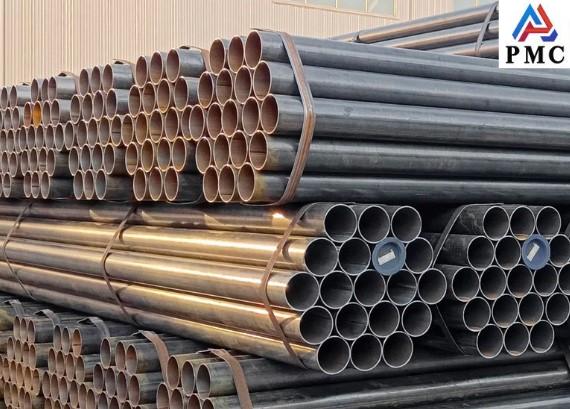
Introduction of Mild Steel ERW Pipe
Mild steel ERW pipe, also known as Electric Resistance Welded Pipe (ERW), is manufactured from low-carbon steel using a resistance welding process. Its cost-effectiveness and adaptability have made it a common pipe material in both industrial and civilian applications. The following provides a comprehensive introduction to ERW pipe from five perspectives: core definition, production process, key characteristics, applicable applications, and key selection criteria.
What is mild steel erw pipe?
Raw material properties: Low-carbon steel is used as the base material (carbon content is usually ≤0.25%). This type of steel has good toughness and excellent welding performance, avoiding the problem of cracks easily occurring when welding high-carbon steel. It is an ideal raw material for resistance welding process.
Core of the process: "ERW" (electric resistance welding) is the key process - low-carbon steel strip is rolled into a tube through a forming machine, and then the "resistance heat" generated by the current passing through the steel is used to instantly heat the interface of the tube to a molten state. It is then pressurized and welded using extrusion rollers. No additional filling wire is required, and the welding efficiency is much higher than traditional arc welding.
Product form: The most common form is a round tube, which can also be processed into rectangular tubes, square tubes and other special-shaped tubes according to needs. The tube diameter ranges from 10mm to 630mm, and the wall thickness is usually 0.8mm to 12mm, which is suitable for the pressure and structural requirements of different scenarios.
Production process of mild steel erw pipe
The production process for mild steel ERW pipes is highly standardized, and the core steps can be summarized as follows:
Raw material pretreatment: Flatten and straighten the low-carbon steel strip (in coil form), remove surface oil and rust, ensure uniform thickness and clean surface of the steel strip, and avoid affecting welding quality;
Forming: The steel strip is gradually wound into a tube (round tube or special-shaped tube) of a set diameter through a continuous roll forming machine. During the process, the forming pressure must be precisely controlled to ensure that the interface of the tube blank is aligned;
Resistance welding: Use high-frequency or industrial frequency current to heat the interface of the tube (high-frequency ERW tubes heat faster and have narrower welds). After the interface reaches a plastic state, it is pressurized and welded by squeezing rollers to form a continuous weld.
Subsequent processing: After welding, weld flaw detection (such as ultrasonic testing) is performed to identify welding defects. The pipe is then processed into fixed lengths (such as 6 meters or 12 meters) through sizing and cutting. Finally, anti-corrosion treatment (such as galvanizing or painting) is performed as required to improve corrosion resistance.

Key properties of mild steel erw pipe
1. Significant cost advantages: Low-carbon steel raw material prices are lower than those for stainless steel and alloy steel pipes. The resistance welding process requires no filler wire and boasts high production efficiency (high-frequency ERW pipe can produce hundreds of meters per hour), resulting in unit production costs significantly lower than seamless pipes or arc-welded pipes.
2. Stable welding performance: Low-carbon steel inherently offers excellent welding toughness, and the ERW process's "no-filler welding" reduces weld impurities, resulting in weld strength reaching 85%-95% of the base material strength, meeting the strength requirements of most low-pressure and structural support applications.
3. High Processing Flexibility: Pipe diameter and wall thickness can be flexibly customized by adjusting the forming mold (e.g., from narrow-diameter conduit to medium-diameter water pipes). The pipes are also easy to cut, drill, and bend, adapting to on-site installation requirements.
4. Limitations to Note: Due to its low carbon content, mild steel has poor corrosion resistance (requiring galvanizing, painting, and other anti-corrosion treatments). Although welds have been tested, they still exhibit potential stress concentration compared to seamless pipes, making them unsuitable for high-pressure (e.g., ultra-high-pressure oil pipelines), high-temperature, or highly corrosive environments (e.g., acidic and alkaline chemical environments).
Application areas of mild steel erw pipes
Due to its low cost, medium strength, and easy processing, the application of mild steel ERW pipes is concentrated in low-pressure transportation, structural support, civil infrastructure engineering and other fields. Typical scenarios include:
Civil construction field: used for building water supply and drainage pipes (non-drinking water, requires galvanizing), indoor threading pipes (protection of wires and cables), steel structure frame supports (such as purlin support pipes in light steel structure workshops);
Municipal engineering: used as urban low-pressure water supply pipes, rainwater drainage pipes (mostly galvanized or painted), road guardrail posts (special-shaped low-carbon steel ERW pipes, such as square and rectangular pipes);
Industrial auxiliary field: used for factory low-pressure compressed air pipelines, cooling water pipes (non-corrosive media), equipment support pipes (such as machine tools, production line structural support);
Agriculture: used as farmland irrigation pipes (requires anti-corrosion treatment) and greenhouse frame pipes (lightweight and low cost).
Read more: ERW Pipe vs GI Pipe
- 【Prev】 : Rectangular Tube vs Round Tube
- 【Next】 : Materials of SMLS Pipes for Oil Transportation


